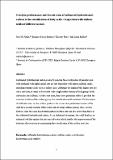Por favor, use este identificador para citar o enlazar a este item:
http://hdl.handle.net/10261/154638COMPARTIR / EXPORTAR:
 SHARE SHARE
 CORE
BASE CORE
BASE
|
|
| Visualizar otros formatos: MARC | Dublin Core | RDF | ORE | MODS | METS | DIDL | DATACITE | |

| Campo DC | Valor | Lengua/Idioma |
|---|---|---|
| dc.contributor.author | Fraile, José M. | - |
| dc.contributor.author | García-Bordejé, José Enrique | - |
| dc.contributor.author | Pires, Elísabet | - |
| dc.contributor.author | Roldán, Laura | - |
| dc.date.accessioned | 2017-09-01T09:03:19Z | - |
| dc.date.available | 2017-09-01T09:03:19Z | - |
| dc.date.issued | 2015 | - |
| dc.identifier | doi: 10.1016/j.jcat.2014.12.032 | - |
| dc.identifier | e-issn: 1090-2694 | - |
| dc.identifier | issn: 0021-9517 | - |
| dc.identifier.citation | Journal of Catalysis 324: 107-118 (2015) | - |
| dc.identifier.uri | http://hdl.handle.net/10261/154638 | - |
| dc.description.abstract | Sulfonated hydrothermal carbon is able to catalyze the esterification of palmitic acid with methanol at a higher initial rate per site than other well-known sulfonic solids, including stronger acids such as Nafion-silica. Although the origin of this higher rate per site is not clear, it seems to be related to high surface density of acid groups (both carboxylic and sulfonic). At the same time, their close proximity makes possible the mutual activation of the surface groups for esterification with methanol. The formation of sulfonate esters on the surface produces irreversible partial deactivation of the solid for a second reaction. Other solids able to bring sulfonic groups close, such as Dowex, show the same deactivation pattern, but their sites are less active than those in sulfonated hydrothermal carbon. As an additional advantage, this solid displays enhanced stability against the presence of water, which enables improvement of the behavior after recovery by minimization of the esterification of the surface acid sites. | - |
| dc.description.sponsorship | This work was made possible by the financial support of the Spanish Ministerio de Economía y Competitividad (Project CTQ2011-28124), the European Commission (FREECATS Project, Grant Agreement 280658), and the Gobierno de Aragón (Group E11). | - |
| dc.publisher | Elsevier | - |
| dc.relation | info:eu-repo/grantAgreement/EC/FP7/280658 | - |
| dc.relation.isversionof | Postprint | - |
| dc.rights | openAccess | - |
| dc.subject | Sulfonated hydrothermal carbon | - |
| dc.subject | Acid catalysts | - |
| dc.subject | Esterification | - |
| dc.subject | Deactivation | - |
| dc.subject | Sulfonic solids | - |
| dc.title | Catalytic performance and deactivation of sulfonated hydrothermal carbon in the esterification of fatty acids: Comparison with sulfonic solids of different nature | - |
| dc.type | artículo | - |
| dc.identifier.doi | 10.1016/j.jcat.2014.12.032 | - |
| dc.relation.publisherversion | https://doi.org/10.1016/j.jcat.2014.12.032 | - |
| dc.date.updated | 2017-09-01T09:03:19Z | - |
| dc.description.version | Peer Reviewed | - |
| dc.language.rfc3066 | eng | - |
| dc.rights.license | http://creativecommons.org/licenses/by-nc-nd/4.0/ | - |
| dc.contributor.funder | Ministerio de Economía y Competitividad (España) | - |
| dc.contributor.funder | Gobierno de Aragón | - |
| dc.contributor.funder | European Commission | - |
| dc.relation.csic | Sí | - |
| dc.identifier.funder | http://dx.doi.org/10.13039/501100003329 | es_ES |
| dc.identifier.funder | http://dx.doi.org/10.13039/501100000780 | es_ES |
| dc.identifier.funder | http://dx.doi.org/10.13039/501100010067 | es_ES |
| dc.type.coar | http://purl.org/coar/resource_type/c_6501 | es_ES |
| item.openairetype | artículo | - |
| item.openairecristype | http://purl.org/coar/resource_type/c_18cf | - |
| item.grantfulltext | open | - |
| item.fulltext | With Fulltext | - |
| item.cerifentitytype | Publications | - |
| Aparece en las colecciones: | (ISQCH) Artículos (ICB) Artículos | |
Ficheros en este ítem:
| Fichero | Descripción | Tamaño | Formato | |
|---|---|---|---|---|
| esterificationfattyacid.pdf | 3,96 MB | Adobe PDF |  Visualizar/Abrir |
CORE Recommender
SCOPUSTM
Citations
65
checked on 25-abr-2024
WEB OF SCIENCETM
Citations
61
checked on 28-feb-2024
Page view(s)
371
checked on 22-abr-2024
Download(s)
899
checked on 22-abr-2024
Google ScholarTM
Check
Altmetric
Altmetric
Este item está licenciado bajo una Licencia Creative Commons

